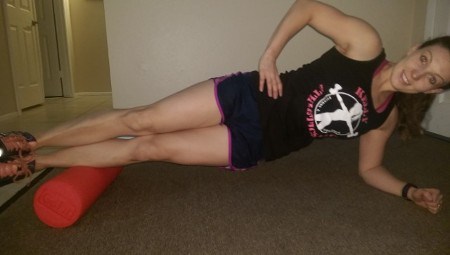The Science Behind and Benefits of Foam Rolling
Foam rolling with Self-Myofascial Release (SMR) is a technique used to inhibit overactive muscles and relieve tension in tight or sore muscles. SMR enhances flexibility, improves muscle tissue response, and reduces muscle soreness. It is difficult to know which muscles are overactive if you aren’t familiar with typical Human Movement Impairments, such as Upper Crossed Syndrome where one’s neck protrudes forward during push-ups or Pronation Distortion Syndrom where ones knees cave in and toes point out during squats. If you want to find out if you have a movement dysfunction, talk to a Corrective Exercise Specialist and get assessed. Untreated human movement impairments can lead to sore muscles/tissue trauma, inflammation, muscle spasms and knots, altered neuromuscular control, muscle imbalance, and eventually – injury.
So how does SMR work? It stimulates the Golgi Tendon Organ (GTO) receptors through sustained pressure. You roll along your overactive muscle until you feel that there is a knot or even a bit of pain. This is the poitn where you will hold the foam roller in place until you feel relief, for 30 seconds up to 2 minutes depending on the severity of your muscle tightness. There are varying levels of intensity you can choose based on the amount of pain you may feel when you foam roll. The more weight you put on the foam roller, the more intense it will feel. The first few times may hurt, but once you keep practicing and repeatedly work on the same muscles, it eventually feels good. My favorite benefits of foam rolling is that it can have similar effects to getting a massage. Not only do you save $65 on a massage but you can do it yourself and get all the knots out in a few short minutes.

When foam rolling in addition to stretching, you can significantly increase your range of motion and flexibility. I encourage you to get started today by getting assessed, learning your corrective exercises, and practice, practice, practice! It can take about 5 foam rolling sessions to start feeling relief and up to 4 weeks to start seeing improvements in your movement dysfunction. It is best to foam roll your overactive muscles with SMR as a preventative strategy before and after each workout, before injury becomes an issue. Once you complete an assessment with your Personal Trainer, you should be given a list of exercises that can help you reduce risk of injury and correct your muscle imbalances. You should start foam rolling at the beginning of your workout program.
Contact Kelly Gibson to learn exercises for Self-Myofascial Release.
Do you have a foam roller and want to start using it? Try my Stretching Plans with photos that include foam rolling techniques.
Contact Me for More Info on my Personal Training or Stretching Plans: